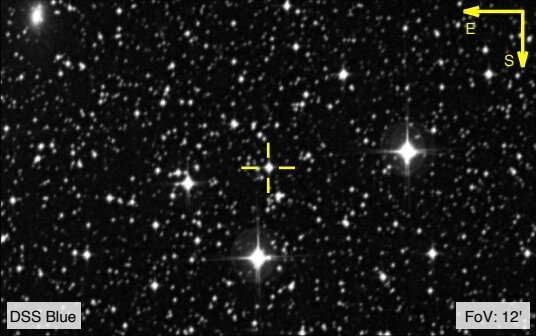DSS blue finding chart for RAVE J183013.5−455510. Credit: Placco et al., 2020.
An international team of astronomers has carried out spectroscopic observations of a distant star known as RAVE J183013.5−455510. Results of this observational campaign show that this object exhibits a peculiar chemical abundance pattern. The finding is detailed in a paper accepted for publication in Astrophysical Journal and posted June 8 on arXiv.org.
Researchers assume that the atmospheres of old, slow-evolving, low-mass, low-metallicity stars contain chemical imprints of primordial stellar populations. Moreover, chemical abundance patterns of extremely metal-poor (EMP) stars could disclose essential information about the nature of the first stars formed in the universe.
Located some 9,000 light years away, RAVE J183013.5−455510 is a relatively bright star that belongs to the metal-weak, thick-disk (MWTD) population of our Milky Way galaxy. Previous studies of this star suggested that it could be an EMP object, and recently, a group of astronomers led by Vinicius M. Placco of the University of Notre Dame, in Notre Dame, Indiana, decided to verify this.
To conduct medium- and high-resolution spectroscopic observations of RAVE J183013.5−455510, the researchers employed the EFOSC-2 spectrograph on the 3.58-meter ESO New Technology Telescope (NTT) and the Magellan Inamori Kyocera Echelle (MIKE) spectrograph on the 6.5-meter Magellan-Clay Telescope. This allowed the team to learn more insights into the chemical composition of the star.
The study found that RAVE J183013.5−455510 has a peculiar chemical abundance pattern. The light elements present similar behavior to those of carbon-enhanced EMP stars not enhanced in neutron-capture elements (CEMP-no), while the heavy elements resemble the abundance pattern of moderately r-process-enhanced stars (r-I).
"This star shows an intriguing chemical abundance pattern, combining a light-element abundance pattern that resembles one of a 'mono-enriched' star with a heavy-element pattern matching either the one from the fast ejecta from a neutron star merger event or the one from a rotating massive star experiencing an r-process event during its explosion," the astronomers wrote in the paper.
According to the study, RAVE J183013.5−455510 has a metallicity at a level of approximately -3.57, which makes it one of the most extremely metal-poor stars currently observed. The results indicate that the star is carbon-, nitrogen and oxygen-enhanced, also showcasing overabundance of such elements as barium, lantan and cerium.
Furthermore, the astronomers investigated the possibility that RAVE J183013.5−455510 may be a binary system, and therefore its peculiar chemical enrichment could be the result of a mass transfer from an evolved companion. However, they did not find any radial velocity variations that could confirm this scenario.
As noted in the paper, the researchers assume that the observed chemical abundance pattern RAVE J183013.5−455510 is most likely a result of a neutron star merger event or was produced during the evolution and explosion of a rotating massive star. They added that further studies focused on lead and thorium abundances in stars similar to RAVE J1830−4555 could reveal the most plausible formation theory.
More information: The R-Process Alliance: The Peculiar Chemical Abundance Pattern of RAVE J183013.5−455510, arXiv:2006.04538 [astro-ph.SR] arxiv.org/abs/2006.04538
Journal information: Astrophysical Journal
© 2020 Science X Network
























